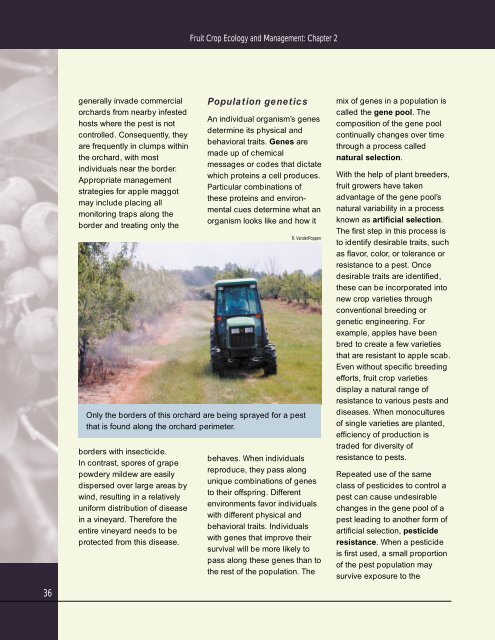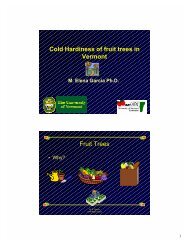Fruit Crop Ecology and Management - UVM Apple Orchard
Fruit Crop Ecology and Management - UVM Apple Orchard
Fruit Crop Ecology and Management - UVM Apple Orchard
You also want an ePaper? Increase the reach of your titles
YUMPU automatically turns print PDFs into web optimized ePapers that Google loves.
36<br />
generally invade commercial<br />
orchards from nearby infested<br />
hosts where the pest is not<br />
controlled. Consequently, they<br />
are frequently in clumps within<br />
the orchard, with most<br />
individuals near the border.<br />
Appropriate management<br />
strategies for apple maggot<br />
may include placing all<br />
monitoring traps along the<br />
border <strong>and</strong> treating only the<br />
borders with insecticide.<br />
In contrast, spores of grape<br />
powdery mildew are easily<br />
dispersed over large areas by<br />
wind, resulting in a relatively<br />
uniform distribution of disease<br />
in a vineyard. Therefore the<br />
entire vineyard needs to be<br />
protected from this disease.<br />
<strong>Fruit</strong> <strong>Crop</strong> <strong>Ecology</strong> <strong>and</strong> <strong>Management</strong>: Chapter 2<br />
Population genetics<br />
An individual organism’s genes<br />
determine its physical <strong>and</strong><br />
behavioral traits. Genes are<br />
made up of chemical<br />
messages or codes that dictate<br />
which proteins a cell produces.<br />
Particular combinations of<br />
these proteins <strong>and</strong> environmental<br />
cues determine what an<br />
organism looks like <strong>and</strong> how it<br />
Only the borders of this orchard are being sprayed for a pest<br />
that is found along the orchard perimeter.<br />
R. V<strong>and</strong>erPoppen<br />
behaves. When individuals<br />
reproduce, they pass along<br />
unique combinations of genes<br />
to their offspring. Different<br />
environments favor individuals<br />
with different physical <strong>and</strong><br />
behavioral traits. Individuals<br />
with genes that improve their<br />
survival will be more likely to<br />
pass along these genes than to<br />
the rest of the population. The<br />
mix of genes in a population is<br />
called the gene pool. The<br />
composition of the gene pool<br />
continually changes over time<br />
through a process called<br />
natural selection.<br />
With the help of plant breeders,<br />
fruit growers have taken<br />
advantage of the gene pool’s<br />
natural variability in a process<br />
known as artificial selection.<br />
The first step in this process is<br />
to identify desirable traits, such<br />
as flavor, color, or tolerance or<br />
resistance to a pest. Once<br />
desirable traits are identified,<br />
these can be incorporated into<br />
new crop varieties through<br />
conventional breeding or<br />
genetic engineering. For<br />
example, apples have been<br />
bred to create a few varieties<br />
that are resistant to apple scab.<br />
Even without specific breeding<br />
efforts, fruit crop varieties<br />
display a natural range of<br />
resistance to various pests <strong>and</strong><br />
diseases. When monocultures<br />
of single varieties are planted,<br />
efficiency of production is<br />
traded for diversity of<br />
resistance to pests.<br />
Repeated use of the same<br />
class of pesticides to control a<br />
pest can cause undesirable<br />
changes in the gene pool of a<br />
pest leading to another form of<br />
artificial selection, pesticide<br />
resistance. When a pesticide<br />
is first used, a small proportion<br />
of the pest population may<br />
survive exposure to the



